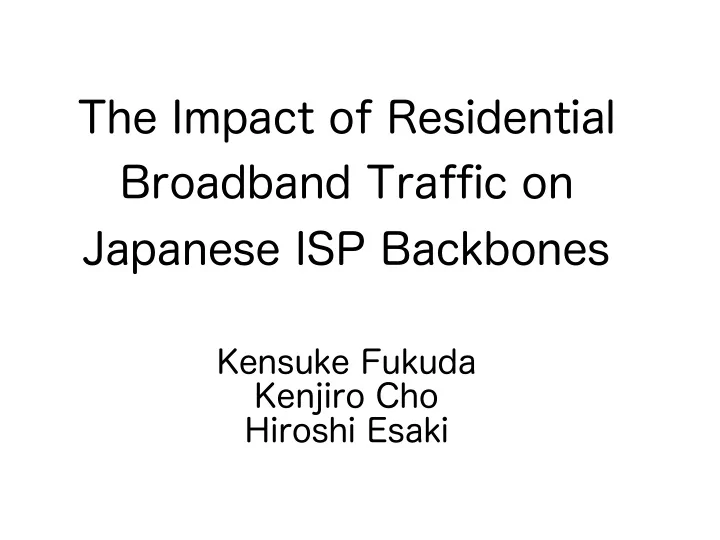

The Impact of Residential Broadband Traffic on Japanese ISP Backbones Kensuke Fukuda Kenjiro Cho Hiroshi Esaki
Outline • Introduction • Motivation • Data collection • Many graphs • Conclusion • (The details are in CCR,vol.35, no.1, 2005)
Increase in residential broadband subscribers in Japan
Traffic growth at 6 major Japanese IXes
Objective of this study residential broadband user traffic users • Characterize macro-level impact of • Volume, growth, and usage pattern • Residential users vs. academic/office • Major IXes vs. private-peering • Regional differences
Data collection kddi, k-opticom, ntt-c, poweredcom, ybb) data per interface in a router series from 7 ISP’s data each for 6 categories • 7 major Japanese ISPs (iij, japan telecom, • Duration: Aug(trial)/Sep/Oct/Nov 2004 • Raw data: 1-month mrtg/rrdtools (2 h. bin) • We reconstructed aggregated traffic time
Traffic groups for data collection centers, dialups peering • (A1) RBB customer: ADSL/CATV/FTTH • (A2) Non-RBB customers: leased lines, data • (B1) External 6 IXes: JPNAP/JPIX/NSPIXP • (B2) External other domestic: local IXes, private • (B3) External international • (C) Regional: 47 prefectures
(A1) RBB customer traffic is constant • Traffic is about 100Gbps, and 70% of traffic • Peak hours: 21:00-23:00 • Difference between weekdays and weekends • In/out volume are almost symmetric
(A2) Non-RBB customer traffic users, 2nd (or 3rd) level ISPs • Leased lines, data centers, dial-up • Peak hours: 21:00-23:00 • Higher activity in daytime on weekdays
Academic traffic • ABILINE (Internet2) • Peak hours: 10:00-14:00 • Lower activity in weekends
(B1&B2) 6 major IXes & other domestic traffic • Both traffic are dominated by RBB customer traffic
Comparison with other data unit: Gbps (B1) 6 IXes All 6 IXes ratio (our data) (directly measured) (%) sep 30.9 74.5 41.5 oct 31.8 77.1 41.2 nov 33.0 80.3 41.1 • Our data covers about 40% of all traffic
(B3) International traffic • In/Out traffic are asymmetric • Triggered from domestic side
Summary of traffic groups 40%) Unit: Gbps (A1) (A2) (B1) (B2) Other (B3) RBB customer RBB other 6IXes domestic International in/out in/out in/out in/out in/out sep 98.1/118.1 14.0/13.6 35.9/30.9 48.2/37.8 25.3/14.1 oct 108.3/124.9 15.0/14.9 36.3/31.8 53.1/41.6 27.7/15.4 nov 116.0/133.0 16.2/15.6 38.0/33.0 55.1/43.3 28.5/16.7 • Growth rate: 6-7% per month (= 200% per year!) • Other domestic (private peering) is NOT negligble • International traffic accounts for 23% of all external traffic • RBB customer traffic in Japan is 330Gbps (= 133.0Gbps/
(C) Metropolitan vs Rural (1)
Metropolitan vs. Rural (2) of prefecture • Traffic volume is proportional to population • Prob. of finding a heavy user is constant
CDF of pref. traffic
Traffic per user by NetFlow • 96% users use less than 2.5GB/day • Traffic is asymmetric for < 2.5GB
Metropolitan vs. Rural (again) • Same behavior except for number of samples • Prob. of finding a heavy user is the same
Symmetry of in/out traffic • Out is 10 times larger than In in for < 10 8 • 2 regions appear for > 10 8 • out is restricted (because of ADSL?) • in and out is symmetric (because of fiber?)
Summary Japanese ISPs. in/out traffic are symmetric negligible • We analyzed residential broadband traffic in • Main results: 1. RBB traffic in Japan is about 330Gbps, and 2. Backbone is dominated by RBB traffic 3. RBB traffic increases at 200% per year 4. Traffic through private peering is NOT 5. RBB traffic is proportional to the population
Concluding remarks • Future work • Improve the accuracy • Compare with traffic in other countries • Microscopic analysis • Locality of flows & application types • Collect 1 month’s data at 6 month intervals
Recommend
More recommend